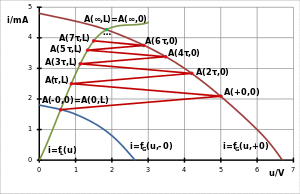
The Bergeron diagram method is a method to evaluate the effect of a reflection on an electrical signal. This graphic method—based on the real characteristic of the line—is valid for both linear and non-linear models and helps to calculate the delay of an electromagnetic signal on an electric transmission line.
Using the Bergeron method, on the I-V characteristic chart, start from the regime point before the transition, then move along a straight line with a slope of Z0 (Z0 is the line's characteristic impedance) to the new characteristic; then move along lines with −Z0 or +Z0 slope until the new regime situation is reached.
The − value is considered always the same at every reflection because the Bergeron method is used only for first reflections.
The method was originally developed by a French hydraulic engineer, L. J. B. Bergeron, for analysing water hammer effects in hydraulic systems.
See also
- Ringing (signal)
- Signal reflection
External links
- Detailed description of the Bergeron diagram method
- Texas Instruments application reports AN-806 Data Transmission Lines and Their Characteristics and AN-807 Reflections: Computations and Waveforms, 2004